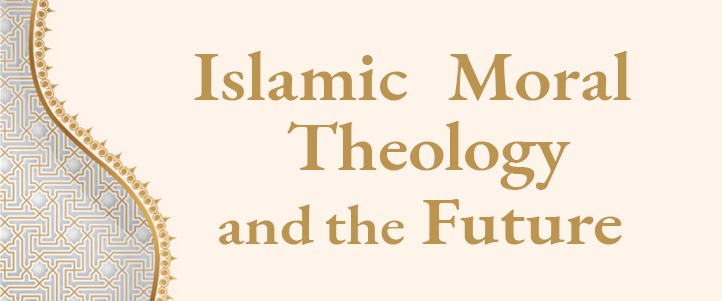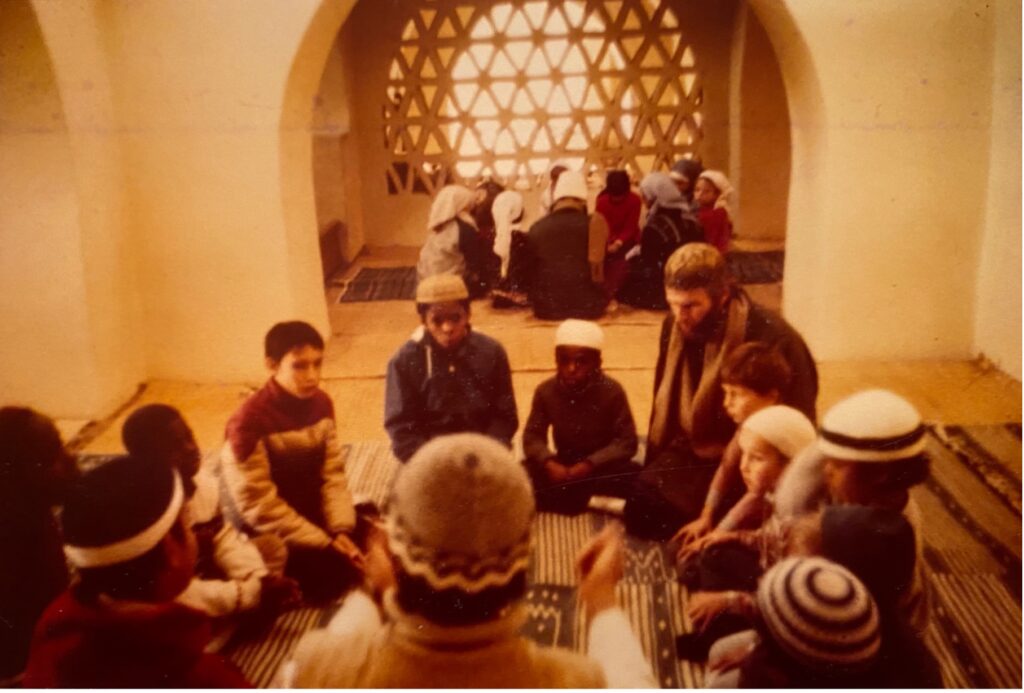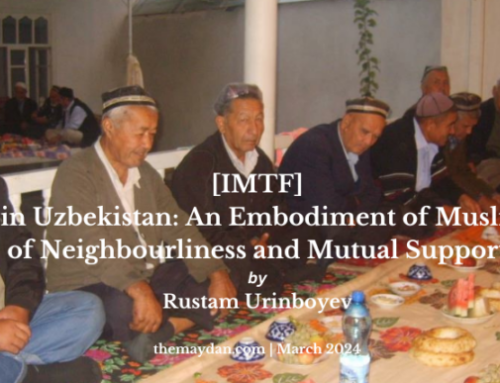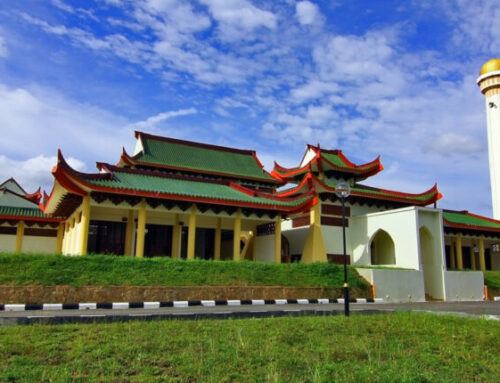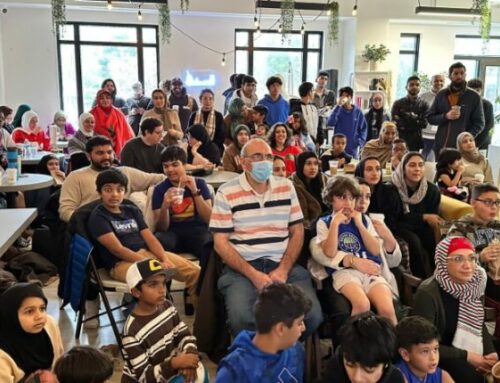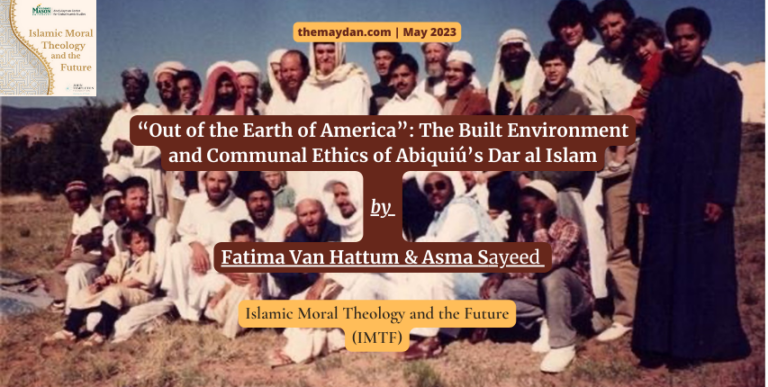
“Out of the Earth of America”: The Built Environment and Communal Ethics of Abiquiú’s Dar al Islam
Introduction
Atop a rural mesa in Northern New Mexico, where the high desert meets riparian woodlands, there is an adobe mosque. Nubian by design, funded by the Saudi royal family, and built by the hands of an incredibly diverse group of Muslims and non-Muslims, its existence and location simultaneously evoke the familiar and the foreign. The mosque is part of Dar al Islam (DAI), a foundation incorporated in 1979 with the purchase of 5,000 acres of land in Abiquiú based on a vision of establishing a self-sustaining Muslim community. Throughout the late 1970s and 1980s, 40 families moved from across the U.S. and abroad to form a unique and diverse intentional community, comprised primarily of Black and White converts, as well as Arab and South Asian American Muslims. This group of Muslims collaborated with Abiquiú’s Indigenous and Hispano Pueblo and local community to build an internationally recognized adobe mosque and madrasa complex.
The community piqued the global Muslim imagination—it was primarily funded by the Saudi Princess Moudi bint Khalid al Saud and endorsed by the Muslim World League. The iconic building was designed by the internationally renowned Egyptian architect, Hassan Fathy (1900-1989), author of Architecture for the Poor. It is reported that Fathy, who believed that architecture must reflect its vernacular contexts, was reluctant to undertake the project as he was not familiar with Native American building practices. (Steele, 1997, p. 185) Nevertheless, he was ultimately persuaded to design not just the mosque but a full-scale traditional Middle Eastern medina. In 1980, Fathy and two master builders from Nubia arrived in Abiquiú. They came to work alongside Muslims and non-Muslims of diverse cultural, national, and racial backgrounds and to guide them in building a Nubian-style adobe mosque with domes, barrel vaults, and squinches – architectural features previously unknown in the American Southwest.
Since its founding, the building and community have hosted tens of thousands of Muslims and non-Muslims with widely varying religious and spiritual orientations, and many well-known American Muslim leaders and scholars of Islam have also spent time at DAI. However, in the early 1990s, the madrasa, a victim of international geopolitics and related funding shortages, was closed, precipitating the departure of many families. Over time, the site was repurposed into an event and retreat space, though the original plan for DAI remains unrealized. Nevertheless, this unique experiment is fertile ground for exploring transnational Muslim communal ethics. This essay re-traces the vision of two of the key American founders, Nooruddeen and Noura Durkee, and the Egyptian architect, Hassan Fathy, and highlights the complex and profoundly moving community dynamics of the initial DAI residents.
The Original Vision
New Mexico, and Abiquiú specifically, were chosen by the DAI founders for their natural beauty: an integral facet of the DAI vision of a holistic Muslim life. The aesthetic of the land itself was seen as a bedrock for an Islamic community. Nooruddeen Durkee (1981), perhaps the most instrumental of the founders of Dar al Islam, described the chosen site as follows:
On this single site there are two distinct aspects: one that is lofty, imposing and open to the sky – a sky that extends to distant horizons where it blends with the land, so that cloud and mountains may sometimes merge into one blue haze; and the low-lying land that is sheltered by the mountains and stretches on both sides of the river, fertile, peaceful and welcoming: majesty and peace – two complementary aspects of Islam itself.
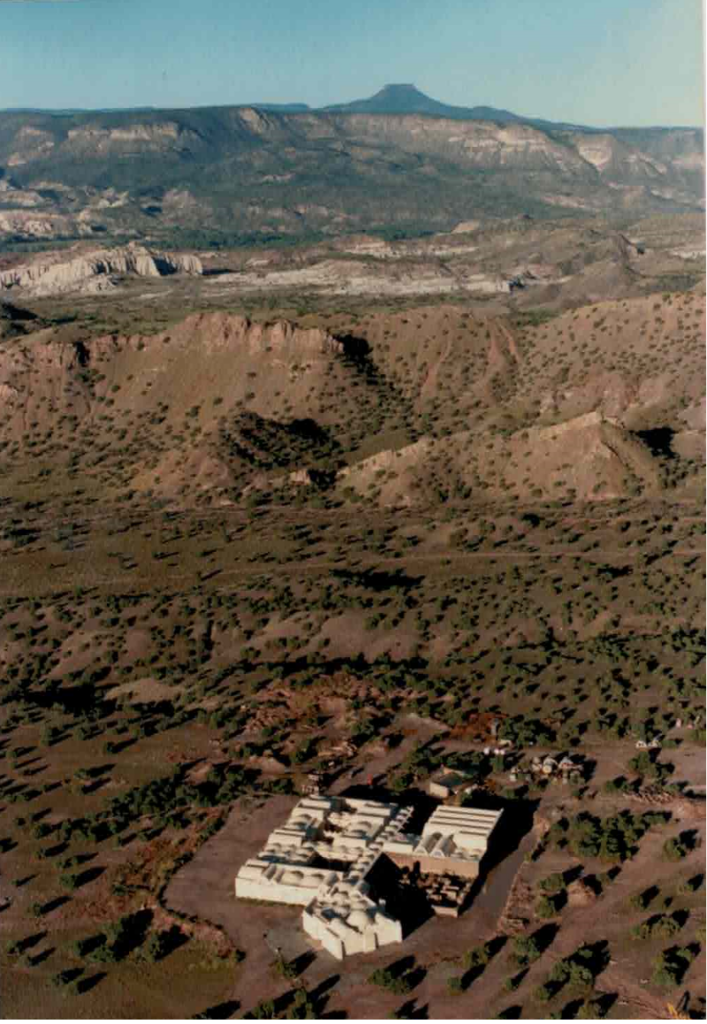
Figure 1 – Aerial View of Dar al Islam

Figure 2 – The Dar al Islam Mosque
The vision of community was deeply place-based and land-based. Figures 1 and 2 provide a glimpse of the “majesty and peace” Durkee described. Additionally, Northern New Mexico and Abiquiú were chosen for their rurality, the possibility to build and live an alternative life with little interference, and what was seen as the region’s “affinities with Islam” (Durkee, 1981, “Why New Mexico?”), including a geographic latitude similar to Southwest Asia and North Africa, Southern Spain, Iran, and Northern India, and a cultural connection between the local Hispano community and the Moors in Spain. Indeed, this relationship between Hispano and Genízaro identities and Muslim and Arab culture has been documented (Córdova, 1992) with Genízaro and Hispano scholars from the Pueblo de Abiquiú writing explicitly about their heritage and connections to both Islam and Arab culture (Córdova, 1992).
The relationship between communal ethics and the built environment was central to the conception of Dar al Islam. The original vision described “Three Fundamental Aspects” (Durkee, 1981) of the project: a public aspect; an academic, educational, and research aspect; and a community aspect. Each aspect detailed how the space would be built to support the intracommunity relationships, as well as the relationship of the community with the broader society. The public aspect was:
…designed to accommodate the visiting public – which we call the “Outer Medinah” – there are no restrictions; it is an open area, not only admitting every kind of visitor, whatever their beliefs, motives or even manner of dress, but actually beckoning them to attend what we have to show them. The Call to Prayer need not interrupt their round of viewing…unless the very ambience should move them to that degree, for they will hear the Call and some may respond, but there is no compulsion. The gateway to the Outer Medinah will be open to all comers. (Durkee, 1981, “The Three Fundamental Aspects”)
Physically, this domain was to include the entrance and a complex including a market, hotel, and museum. In contrast, the academic, educational, and research aspect was designed to be restricted to Muslim and non-Muslim staff and students, master-craftspeople, scholars, and researchers. The intention was to create a space where “worship and study must not be impeded or interrupted” (Durkee, 1981, “The Three Fundamental Aspects”). Physically, this aspect was to include the mosque, the library, the school, a health center, and a farm and agricultural center. Finally, the community aspect was centered on the private domain of the Muslim community and their families as they engaged in “bringing up their children…bound together as a community by the tasks and faith they share” (Durkee, 1981, “The Three Fundamental Aspects”). Physically, this domain referred to the housing and homes. Figures 3 and 4 are the original plans for the community (note that numbers 15 and 16 in Figure 3 were all that was completed of the original plans).
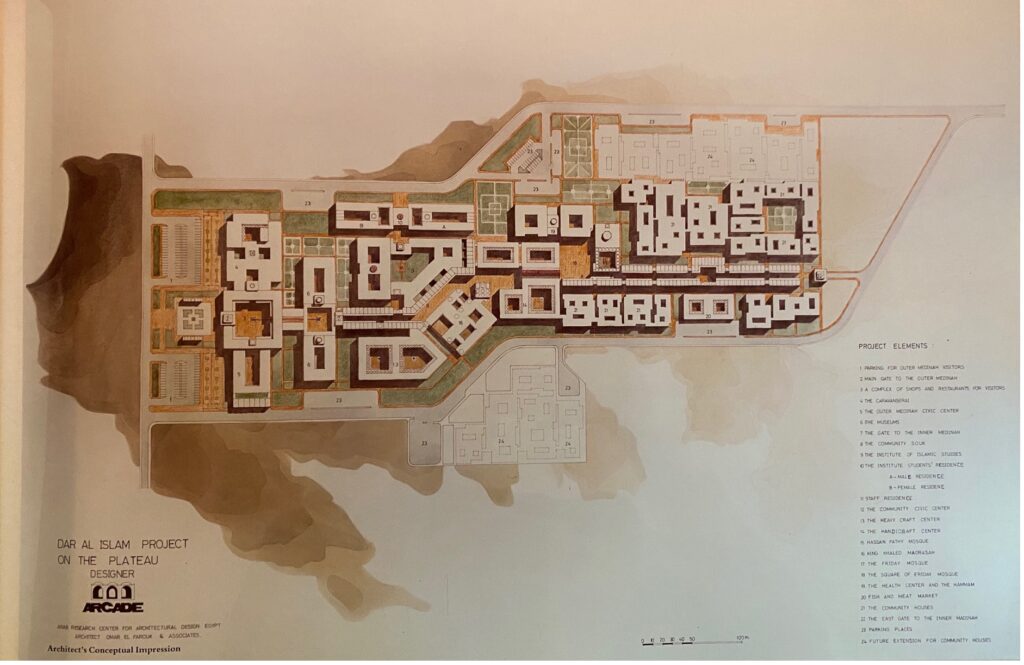
Figure 3 – Original Community Plans
The Architect
The Dar al Islam mosque-madrasa complex is celebrated as one of Hassan Fathy’s final architectural contributions. Like Fathy’s famed New Gourna in Egypt, Dar al Islam was originally an expansive project: a rare opportunity to build a village from scratch, to unite individuals and families in the service of creating a new community aligned with his ideas of environmentalism and sustainable building. Dar al Islam thus exercised his imagination at a grand scale. With lessons learned from New Gourna, Fathy was given a second chance in an entirely different cultural and national context to (re)articulate his philosophy of communal ethics. The racial, sectarian, and cultural diversity that defined the DAI residents was only one of the differences as he reprised New Gourna in Abiquiú. The challenges of the North American context forced the founders to severely curtail their original plan. Nevertheless, what stands is infused with Fathy’s vision of communal ethics which still inspires those who inhabit this space, even if fleetingly.
Over the course of his career, Fathy developed an acute sense of the importance, and indeed necessity, of community for sustaining any meaningful architectural tradition. Such a tradition would in turn be able to address basic human needs for housing while being attentive to other socio-economic, environmental, and cultural variables. Three principles, articulated in Fathy’s vision for New Gourna, are indelibly embedded in the spaces of Dar al Islam in New Mexico.
First, Fathy viewed communities as spaces for individuals to exercise their unique decision-making powers thereby fulfilling the covenant (amāna) referred to in the Quran (al-Ahzāb 33: 72). Communities were “delicately balanced social organisms integrated with the topography, with the very bricks and timber of the village” (Fathy, 1973, p. 9). Within that context, each individual has profound moral and ethical responsibilities for every decision (Fathy, 1973). Thus, the design of any community must not only integrate local environmental considerations but also reflect the diverse needs and aesthetics of individual community members. In part, Fathy’s assertion of individuality related to his strident rejection of the increasingly global hegemony of industrial building practices that rarely incorporated local elements and imposed a uniformity of design across rural and urban spaces. More significantly, he believed that building was a creative activity which entailed deliberation and choice. In these spaces of decision-making, individuals and communities exercised their amāna: every minute decision had an impact both on the one who was building as well as on the built environment. His insistence on an individual’s engagement with the building process, not just with his hands, but also with his heart and mind, is powerfully conveyed in the following: “This is, in fact, one of the most important aspects of the human predicament, that all man’s decisions change the world, that he cannot escape the decisions, and that he is conscious of the good or the evil he does, the beauty or the ugliness he creates” (Fathy, 1973, p. 11).
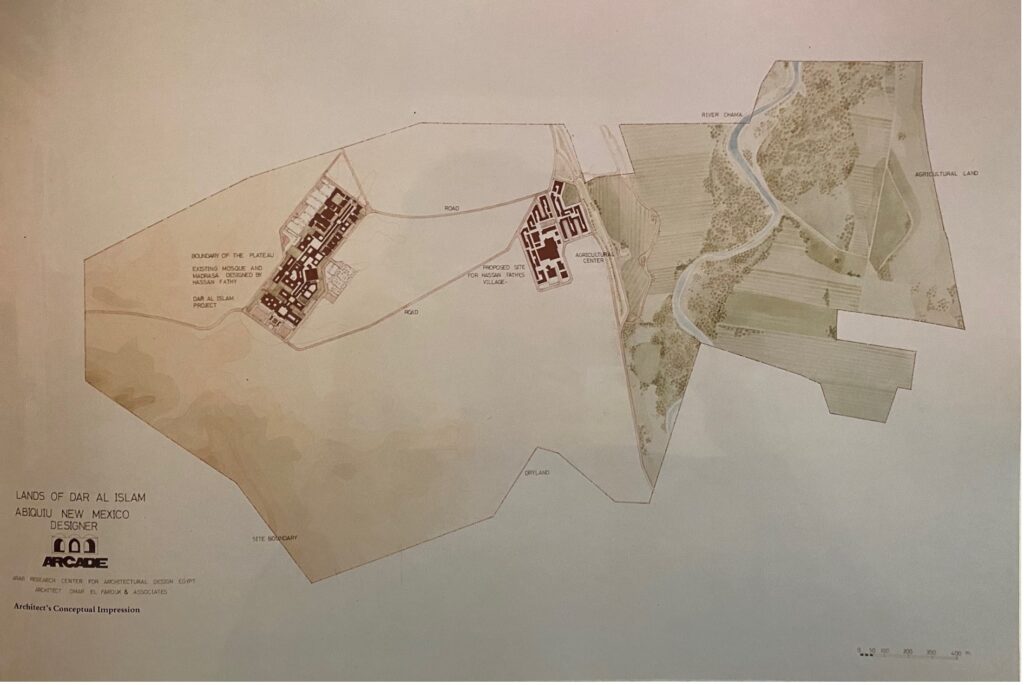
Figure 4 – Original Community Plans Including the Valley and Farm
A second principle was that beauty (jamāl) is necessary for sustaining the human experience; therefore, built environments, even the most humble of them, should be beautiful. Fathy’s emphasis on beauty echoes the widely-circulated Prophetic tradition, “Allah is Beautiful, and He loves beauty (inna Allaha jamil yuḥibbu al-jamāl).” He recounts his dismay at the impoverished Egyptian town of Talkha where the “sight and smell of the narrow streets, deep in mud and every kind of filth, where all the garbage of the kitchens—dirty water, fish scales, rotting vegetables, and offal—was regularly thrown” (Fathy, 1973, p. 2). For Fathy, a life devoid of beauty was a dehumanized one. His plans for New Gourna thus included spaces where citizens could devote themselves to creating beauty through traditional crafts such as weaving, pottery, and woodworking. Developing these skills would help to maintain centuries-old traditions of crafts in Egypt and provide sustainable income for the inhabitants. These concepts ultimately found their way into the plan for Dar al Islam as well, which was to include workshops for nurturing traditional Islamic crafts, training future generations, and providing revenue for the new Muslim community. Although the expansion of the compound beyond the mosque-madrasa complex was not fulfilled, it is perhaps no accident that the remaining members of the founding community still nurture and sustain the practice of a range of crafts, from woodworking and calligraphy to weaving and other textile crafts. It may well be that future generations build on Fathy’s vision and that Abiquiú, home to a thriving, culturally and religiously pluralistic craftspeople, could also become a center for Islamic crafts in North America.
A third guiding principle of Fathy’s communal ethics was the necessity of individual and communal engagement in building and maintaining one’s own dwelling as well as communal spaces. The labor of designing one’s space, making and laying adobe bricks, building doors and windows, and ultimately furnishing and decorating should be one in which each individual is engaged. Unlike the modern building process in which most labor and decisions are outsourced to others, Fathy insisted that the families who inhabit a community be intimately connected with the process of creating and maintaining their own spaces. Their participation, in turn, would generate pride of ownership and a sense of accomplishment. It would also deepen community solidarity as neighbors would support each other in the construction of these spaces. Most importantly for Fathy, this was the only viable way to nurture a tradition of local (that is, place-based) and sustainable craftsmanship that could then be transmitted across generations. Here, Fathy’s plans for Dar al Islam had to be significantly modified to accommodate different cultural contexts. For example, mud-brick constructions require the annual communal Herculean labor of renewing the waterproof plaster coating every year. In the American context, such annual cooperation in a fledging, unstable communal setting was deemed improbable (Steele, 1997, p. 186). Both building codes and the high desert climate necessitated allowing for waterproof roofing and other non-traditional building materials. Notwithstanding such modifications, there exists an underlying ethos that if Dar al Islam is to persist as a sacred trust (amāna) that nurtures beauty (jamāl) in harmony with nature and the built environment, it will necessitate profound individual and communal engagement.
Community Life
This original vision for Dar al Islam was highly ambitious and, while the full extent was never achieved, key aspects of the built environment did come to fruition as the original vision infused early community relations. The mosque and madrasa represented both the physical and the metaphorical process of community building. As Durkee (1985) described:
We are trying to establish something here that grows out of the earth of America. This will take a long time, with a tremendous effort of hard labor, brick by brick and bit by bit…But it is something that we hope, in the process of the labor involved and the concentration involved, will produce a synthesis of Islamic feeling, ideals and knowledge with the life of the people of America. You can see this in the many cultures represented in the children and teachers here. It’s a melting pot, and the time it is taking to build this simple but substantial building is allowing us all to get to know each other and to live together and to know each other’s different ideas and experiences of Islam. (Quoted in Spiker, 1985)
Indeed, this aligned with Fathy’s vision of communal ethics. This simultaneous process of building from the earth and coming to know each other was the essence of the lived communal ethics of the early Dar al Islam community.
It is important to mention here that adobe is also the traditional building material of the Indigenous Pueblo peoples of Northern New Mexico. The idea of establishing “something here that grows out of the earth of America” was represented in the physicality of constructing a building entirely made of earth—the very same mud used for millennia by the original Indigenous inhabitants of the mesa. In that vein, many members of Abiquiú’s Indigenous Genízaro and Hispano Pueblo were part of the construction crew that built the mosque and madrasa. This intention to “establish something here that grows out of the earth of America” was also represented in the original 40 families who moved to Abiquiú from across the U.S. and abroad to form a unique and incredibly diverse intentional community, comprised primarily of Black and White converts, as well as Arab and South Asian immigrants (see Figures 5 – 7).
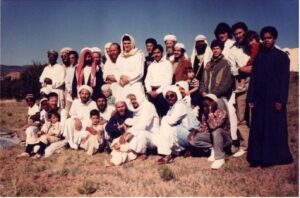
Figure 5 – Community Members at an Eid Celebration in the 1980s
The journeys of Black Muslims and interracial Muslim couples in the community were primarily from urban centers to rural New Mexico seeking a land based spiritual life outside of urban centers and the constraints of racism and violence, some having come to mainstream Sunni Islam through the Nation of Islam. White Muslim converts often found Islam and the community through interests in Eastern spirituality and alternative living. The journeys of South Asian and Arab American Muslims were often rooted in immigration stories and the quest for an idyllic, rural Muslim life. Nearly all community members were seeking spiritual proximity to Allah, Islamic community life, and schooling for their children. The specific history of the founding community, their multi-ethnic make up, the process of community-building, and their search for spirituality produced a truly American articulation of Islam.
Through nearly 10 foundational oral history interviews with community elders, key themes related to communal ethics were revealed.[1] For example, early community member, Aisha Abdul-Aziz Beveridge, a Black convert from New York City, described her family’s process of moving to Abiquiú as follows:
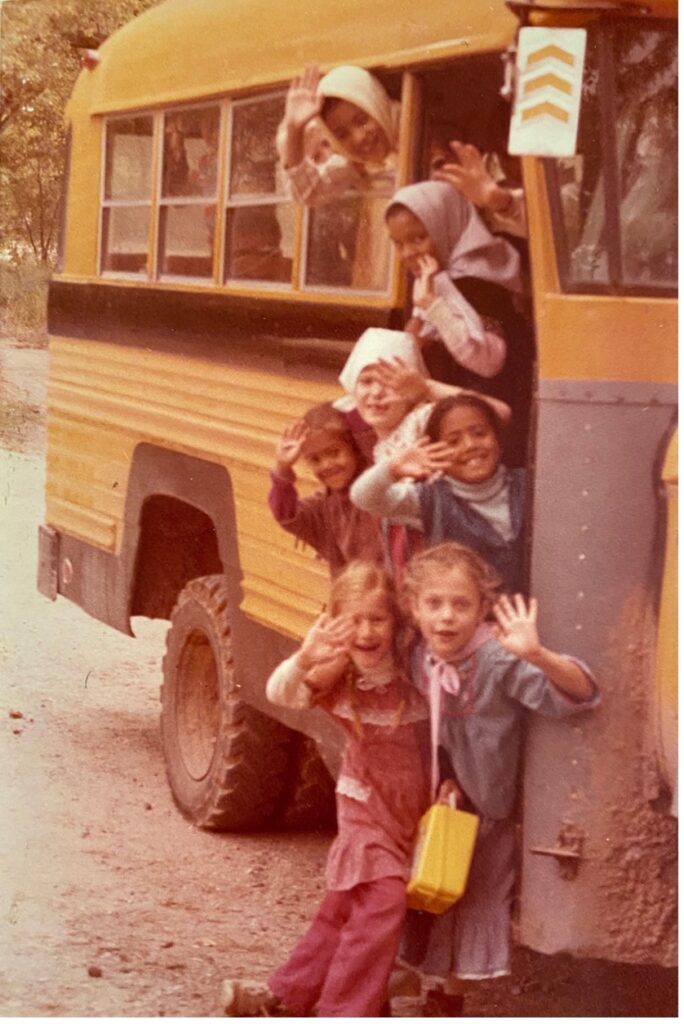
Figure 6 – Children in the Community
It was the late 1970s and New York City was difficult. We didn’t know where we were going to send our children to school. For us, we felt almost like it was making hijra, leaving one place and coming to a new place and finding a whole different paradigm, because coming here also took our Islam on a totally different perspective. That was when we got involved with tasawwuf…But for the first seven months, I couldn’t settle in. Because here we are coming from New York City…and now here I am on two miles of dirt road before I even get to my house. A woodstove to heat the house. I mean, we didn’t know anything about chopping wood. We just turned up the thermostat in New York.
Figure 7 – Children Inside the Mosque
Abdul-Aziz Beveridge moved to New Mexico with her husband, Umar, a convert of European descent whose family came from Scotland. As community members such as the Abdul-Aziz Beveridge family moved to Abiquiú from urban contexts, there was a communal learning and sharing around how to live in a rural context, which often involved deep reliance upon one another. Further, with such a diverse community of Muslims, the majority of whom were converts, a central feature was learning to live in community across differences of race, class, origin, and Islamic beliefs. For example, Bayyinah Muhammad (see Figure 8), who came to Islam through the Nation of Islam and was the first teacher at Dar al Islam, described how:
The first wake up was, ‘the White man is not the devil, they are also Muslims like me.’ That was a big transition for me, to be in a Black community my whole life and come and live in a more White community. Munira Declerck [a child in the community] with red pigtails and Dutch shoes came walking up to me saying, ‘Salaam Alaikum Amiti [Aunty] Bayinnah.’ And wow, that blew my mind and I had to change this whole paradigm of thinking and clean my heart of prejudice. I went through the evolution like Malcom did, and it was through Abiquiú. This is how I found my way into it. Abiquiú is where I realized that people are just people, some lovely, some horrible.
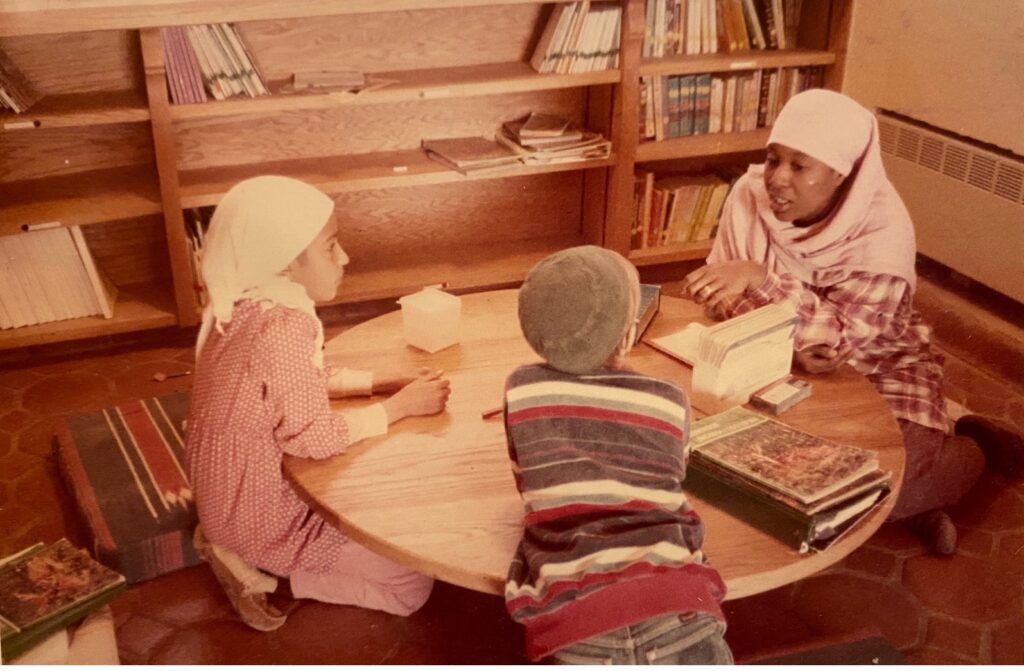
Figure 8 – Bayyinah Muhammad Teaching
Each community member came with an origin story, often considerably different from the rest. The result was a deep experiment in communal relations. Another community member, Abdur Rahim Lutz, was a White convert originally from Colorado who came to Islam during and following a prison sentence for “draft evasion” due to his conscientious objection to fight in the Vietnam War (see Figure 9). The Lutz family were perhaps the first community members to live in Abiquiú and, Abdur Rahim, who was instrumental in building the mosque, described how within the community:
There were as many different psychologies of people you could look for and so it was kind of a good way to interact with people…there was a lot of need to work on your nafs and attachment to your opinions…you had a number of self-appointed experts of Islam…we had the whole mix here…like you have everywhere. You had people and all they wanted to do was dhikr and you had people who were uptight because, ‘all you want to do is dhikr’…Then you had people trying to raise goats who basically should have been trying to raise a kitten first…So, there was always this sense of, like, if you didn’t take yourself too seriously…then you could actually function.
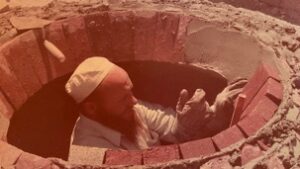
Figure 9 – Abdur Rahim Lutz Building a Dome
The proximity, the complexity, and the idiosyncrasies of communal life also brought support and indelible bonds. For example, Bayyinah Muhammad described how community members helped to raise each other’s children and support each other through parenting. Finally, alongside and woven into these communal relations was the physical and built environment which had transformative spiritual impacts. Indeed, Muhammad described the significance of place upon her Islamic spiritual development:
Me finding what I felt like was the truth and the connection to God that I always wanted…I believe that I achieved that in Abiquiú… I would get up at three in the morning…and just sit on the prayer rug in the dark and just talk to Allah…I feel like physically it’s a magical place. There’s the Indigenous holiness and their roots…it just seems like it’s a coming together of a lot of people and a lot of things. It’s a spiritual hub of some sorts maybe, or a door…there’s something there that you feel.
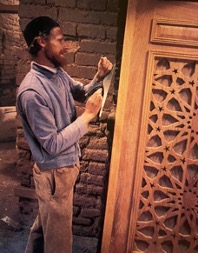
Figure 10 – Benyamin van Hattum Carving the Mosque and Madrasa Doors
Conclusion
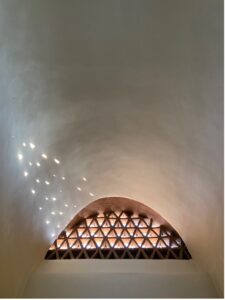
Figure 11 – Light Entering a Barrel Vault inside the Mosque
While the intentional community aspect of Dar al Islam ended during the early 1990s, the legacy remains in the depth of community connections across generations and across locations. Decades later, and in some cases, oceans apart, many of those relationships remain intact reflecting a unique and profound example of transnational Muslim communal ethics. The legacy of the community and Dar al Islam also remains in the building itself, which continues to host Muslims and non-Muslims as a space for learning, connection, and spiritual contemplation. Ultimately, the process of building the mosque and community—brick by brick—was an experiment in rural, multiracial, American Muslim communal ethics and place-based adobe aesthetics. The result, physically and relationally, is a story of transnational and local Islam and the complex process of Muslim community building in the United States.
[1] These oral history interviews are part of a larger project to document Dar al Islam and the community’s history that one of the authors (Fatima van Hattum) is currently completing. The project aims to compile and share the stories of the community more comprehensively in the future. This essay cannot encompass all the community voices but focuses specifically on key experiences relevant to this topic.
References
Córdova, B. G. (1992). Facsimile of Islamic influence on the Hispano and Genízaro. 56 pages. Smithsonian Institutional Archives. Transcribed and edited by Gregorio Gonzales (2022).
Durkee, N. (1981). The Dar al~Islam Foundation [Annual Report]. Dar al Islam.
Fathy, H. (1973). Architecture for the poor: An experiment in rural Egypt. University of Chicago Press. [Pages cited here refer to the following online PDF: https://archive.org/details/ArchitectureForThePoor-English-HasanFathy/page/n11/mode/2up )
Spiker, A. Q. (1985). New Mexico’s Dar al Islam works to build community from the earth of America [Saudi Report]. Dar al Islam.
Steele, James (1997) An Architecture for People—The Complete Works of Hassan Fathy. Thames and Hudson.

